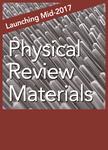版权所有:内蒙古大学图书馆 技术提供:维普资讯• 智图
内蒙古自治区呼和浩特市赛罕区大学西街235号 邮编: 010021

作者机构:Mork Family Department of Chemical Engineering and Materials Science University of Southern California Los Angeles California 90089 USA Institute of High Performance Computing Agency for Science Technology and Research 1 Fusionopolis Way 16-16 Connexis 138632 Singapore Departments of Materials Science and Engineering & Mechanical Engineering and Applied Mechanics University of Pennsylvania Philadelphia Pennsylvania 19104 USA
出 版 物:《Physical Review Materials》 (Physic. Rev. Mat.)
年 卷 期:2018年第2卷第4期
页 面:043401-043401页
核心收录:
基 金:Agency for Science Technology and Research A*STAR
主 题:Diffusion First-principles calculations Microstructure Temperature Thermodynamics
摘 要:The complete process of amorphization and crystallization of the phase-change material Ge2Sb2Te5 is investigated using nanosecond ab initio molecular dynamics simulations. Varying the quench rate during the amorphization phase of the cycle results in the generation of a variety of structures from entirely crystallized (−0.45 K/ps) to entirely amorphized (−16 K/ps). The 1.5-ns annealing simulations indicate that the crystallization process depends strongly on both the annealing temperature and the initial amorphous structure. The presence of crystal precursors (square rings) in the amorphous matrix enhances nucleation/crystallization kinetics. The simulation data are used to construct a combined continuous-cooling-transformation (CCT) and temperature-time-transformation (TTT) diagram. The nose of the CCT-TTT diagram corresponds to the minimum time for the onset of homogenous crystallization and is located at 600 K and 70 ps. That corresponds to a critical cooling rate for amorphization of −4.5 K/ps. The results, in excellent agreement with experimental observations, suggest that a strategy that utilizes multiple quench rates and annealing temperatures may be used to effectively optimize the reversible switching speed and enable fast and energy-efficient phase-change memories.